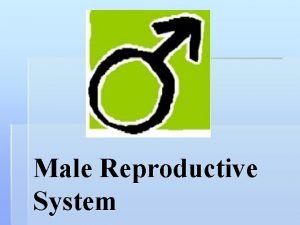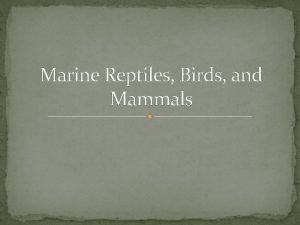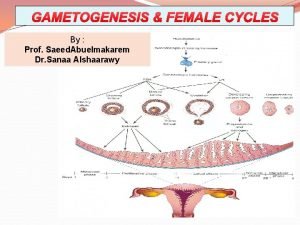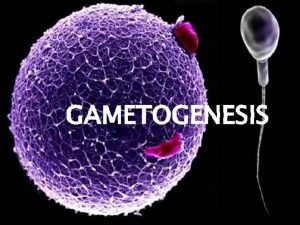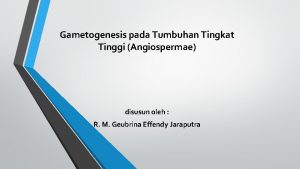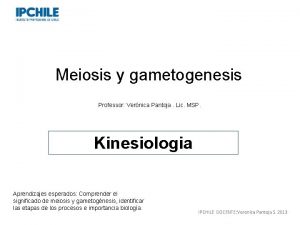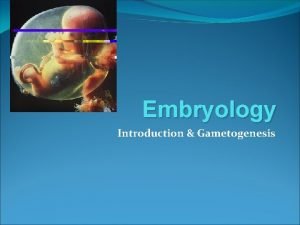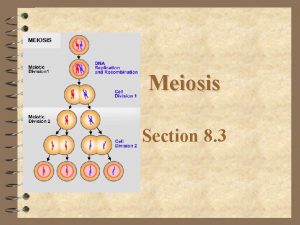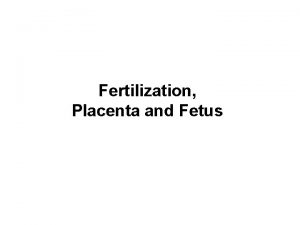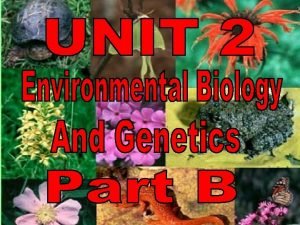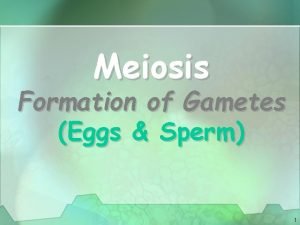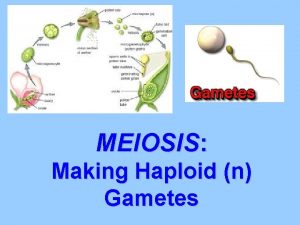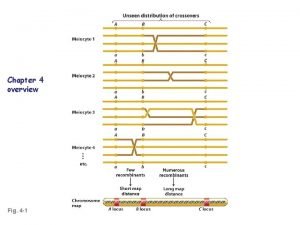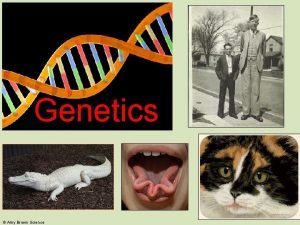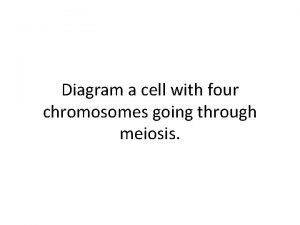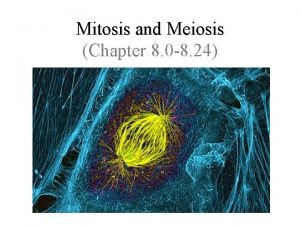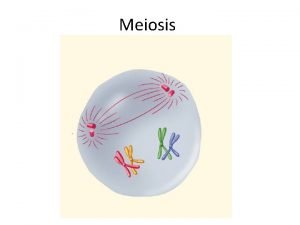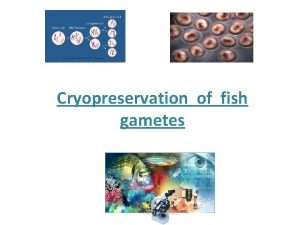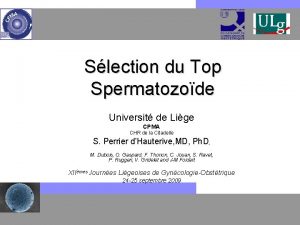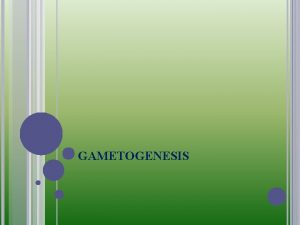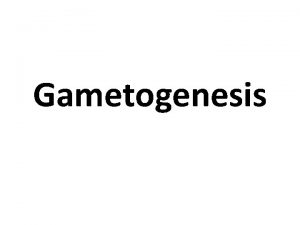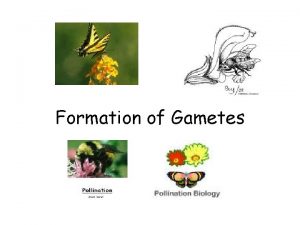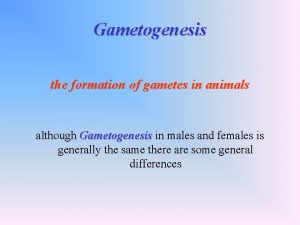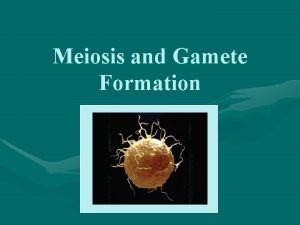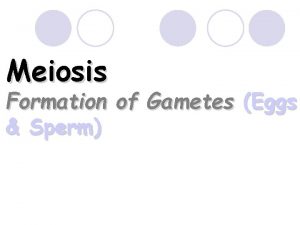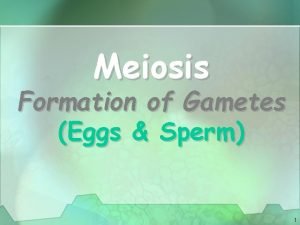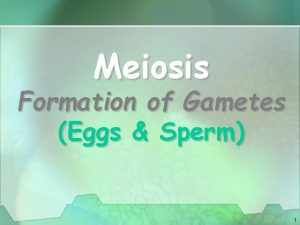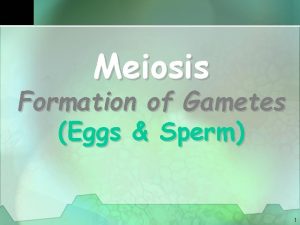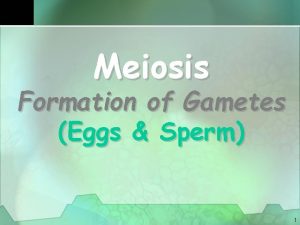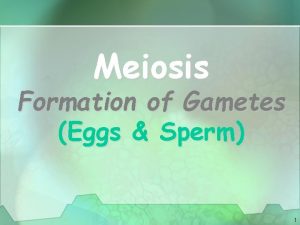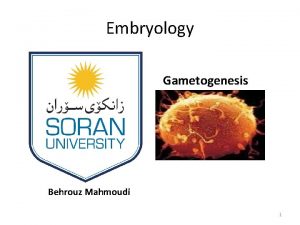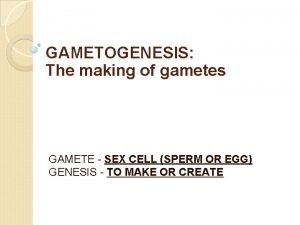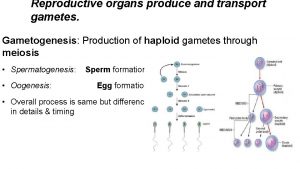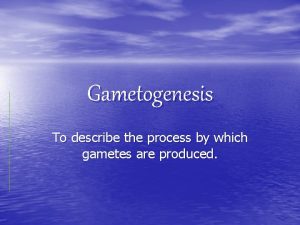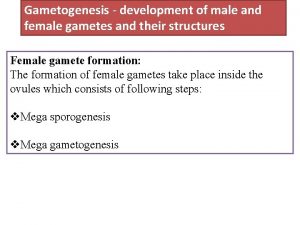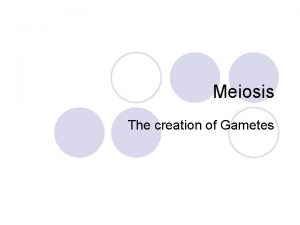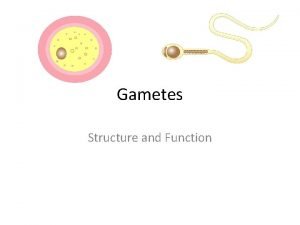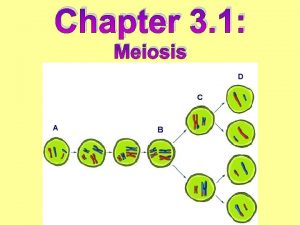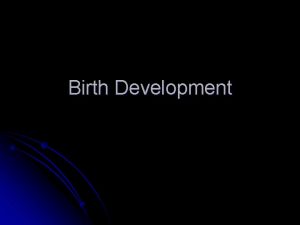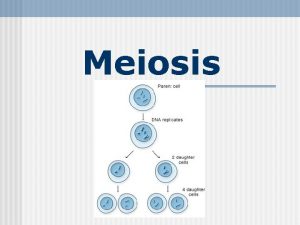Gametogenesis Formation of the mature gametes sperm or




























- Slides: 28


Gametogenesis �Formation of the mature gametes (sperm or ova) from the primordial germ cells

Where Sperm or Ovum are formed? It is formed inside the gonads (testis or ovary) Mature ovum Mature sperm

Falopian tube Body of Uterus Ovary cervix of Uterus vagina Female Reproductive System

Male genital system 1 - Testes 2 - epididymis 3 - vas deferens 4 - spermatic cord 5 - seminal vesicle 6 - ejaculatory duct 7 - prostate gland 8 - penis

epididymis Site in seminiferous tubules in testis and stored in epididymis. Time: starting at puberty and continues till old age. seminiferous tubules

Source of primordial germ cells yolk sac -Primitive germ cells appear at caudal part of yolk sac at the 2 nd week.

Then at the end of 5 th week, they migrate to reach developing gonads ovary in female). testis in male

In males: Primitive germ cells will be present in seminiferous tubules of testis and named spermatogonia.

cortex of ovary In females: Primitive germ cells will be present in cortex of ovary and named oogonia.

Aim of Gametogenesis Production of mature male and female gametes with the following changes: 1 - Nucleus: reduction of diploid number (46 chromosomes) into haploid number (23 chromosomes). 2 - Cytoplasm: Increase in size in ova and markedly reduced in sperms.

SPERMATOGENESIS ** Definition: It is the process of formation of the sperms (mature male gametes) from the primordial germ cells (spermatogonia). ** Site: It occurs in the seminiferous tubules of testis and stored in epididymis. ** Time: It started at puberty (13 -14 years) and continues till old age.

Period of proliferation Daughter Spermatogonium 46 Period of growth primary spermatocytes 46 1 st meiotic division Period of maturation secondary spermatocytes 23 2 nd meiotic division Early spermatid 23 Mature sperm At puberty

** Stages of spermatogenesis ** It includes 4 stages: (1) Stage of proliferation: - Each primordial germ cell (spermatogonium, 46 chromosome) is divided by mitotic division into 2 daughter spermatogonium (each contains 46 chromosomes). (2) Stage of growth: - Each of the daughter spermatogonia acquired more cytoplasm and increased in size forming the primary spermatocyte (46 chromosomes).

(3) Stage of maturation: - In this stage the primary spermatocytes divide by meiotic division as follows: I) 1 st meiotic division (reduction division): each primary spermatocyte divide by meiotic division into two secondary spermatocytes {23 chromosome (one contains 22+X and one 22+Y)}. II) 2 nd meiotic division (equational division): each of the developed secondary spermatocytes divide into two cells called spermatids (each contains 23 chromosomes). N. B; each primordial germ cell (spermatogonium)

Mature spermatid secondary spermatocytes primary spermatocytes spermatogonia Sertoli cell

Mature sperm

(4) Stage of transformation (Spermiogenesis): - It occurs in male only. - Transformation of the spermatid into a mature sperm. The length of the sperm is about 50 - 60 micron. 1. The nucleus forms the head of sperm. 2. The Golgi apparatus forms acrosomal cap which covers the anterior 1/2 of the head. 3. Centrioles, a- Posterior centriole: forms a ring shaped structure at end of the body. b- Anterior centriole: immediately behind the head. - Axial filament arises from anterior centriole and passes through the ring shaped posterior centriole to the tail. 4. Mitochondria from a mitochondrial sheath around the axial filaments between the 2 centrioles. 5. Cytoplasmic membrane form a cytoplasmic sheath around the body and tail.

Characters of normal sperm 1. Length: 65 mm. 2. Number 100 million per ml. 3. Parts of mature sperm: head, neck, body and tail. 4. Motile at ejaculation: more than 80%. 5. Rate of movement in the female genital tract: 5 mm per minute. 6. Survival in the female genital tract: 3 -4 days. Abnormal spermatogenesis: i) Azoospermia: absence of sperms in the seminal fluid ii) Oligospermia: decreased number of sperms in the seminal fluid iii) Increase abnormal forms. If more than 20% affect fertility.

Abnormal forms of sperms

Oogenesis It is a process by which mature ovum is formed from primitive germ cell (oogonium)

OOGENESIS ** Definition; The formation of mature gamete (ova) from the primordial germ cell (oogonia). ** Site: in the cortex of ovary in female. ** Time: It started during foetal (intrauterine) life, continues after puberty completed after fertilization and arrested at the age of menopause.

Daughter oogonium Period of Proliferation Before birth Period of growth Starts Period of maturation At puberty (ovulation) At fertilization primary oocyte 1 st meiotic division Arrested Complete 1 st meiotic division 2 ry oocyte Complete 2 nd meiotic division ootid Mature ovum


** Stages of oogenisis A- During foetal life (1) Stage of proliferation: - Each primordial germ cell; {oogonium} (46 chromosome) is divided by mitosis into 2 daughter oogonia (each contains 46 chromosomes). (2) Stage of growth: - Each of the daughter oogonia increases in size forming the primary oocyte containing 46 chromosomes.

B- After puberty (3) Stage of maturation: I) 1 st meiotic division (reduction division): each primary oocyte divide by meiotic division into one secondary oocytes (contains 22 +X chromosomes and 1 st polar body (contains 22 +X chromosomes and minimal amount of the cytoplasm).

C- After fertilization II) 2 nd meiotic division (equational division): -The secondary oocyte divides into ovum (contains 23 chromosome, 22 + X and most of the cytoplasm) and 2 nd polar body (contains 22 +X chromosomes and minimal amount of the cytoplasm). - The 1 st polar body divided by mitosis into two 2 nd polar bodies. N. B; - The role of the polar body is to reduce the number of chromosomes.

Differences between spermatogenesis and oogenesis Spermatogenesis Definition Formation of the sperms from the Formation Oogenesis of the ova primordial germ cells. primordial germ cell. Site In the testis In the cortex of the ovary Time - It started at puberty from the and - It started during intrauterine life, and continues till very old age (all over continues after puberty life). completed after fertilization. to be - It arrested at the age of menopause. Hormones - FSH and ICSH interstitial cell - FSH and LH stimulating hormone Stages Proliferation, growth, maturation (No and transformation. Results transformation stage) Each primordial germ cell gives 8 Each primordial germ cell gives 2 ova sperms. and 6 polar bodies.
 A tightly coiled tube where sperm mature
A tightly coiled tube where sperm mature Why are sperm whales called sperm whales
Why are sperm whales called sperm whales Stage of menstrual cycle
Stage of menstrual cycle Gametes
Gametes Significado de la meiosis
Significado de la meiosis Whats gametogenesis
Whats gametogenesis Gametosis pada tumbuhan
Gametosis pada tumbuhan Que es gametogenesis
Que es gametogenesis Gametogenesis embryology
Gametogenesis embryology Gametogenesis
Gametogenesis How are somatic cells different from gametes
How are somatic cells different from gametes Meiosis reproduction
Meiosis reproduction Genotypic ratio of dihybrid cross of f2 generation
Genotypic ratio of dihybrid cross of f2 generation Haploid
Haploid Gamete biology
Gamete biology Epididimis berfungsi
Epididimis berfungsi Replicated chromosome diagram
Replicated chromosome diagram 2n haploid or diploid
2n haploid or diploid Gametes
Gametes Amy brown science answer key
Amy brown science answer key Show the cross between a ggbb and a ggbb
Show the cross between a ggbb and a ggbb Cell with four chromosomes
Cell with four chromosomes Meiosis function
Meiosis function Dihybrid cross
Dihybrid cross Foil method biology
Foil method biology Process of gametes
Process of gametes Cryopreservation of fish gametes
Cryopreservation of fish gametes Interesting facts about the integumentary system
Interesting facts about the integumentary system Cpma citadelle
Cpma citadelle
